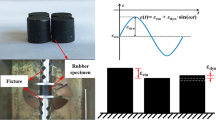Summary
Accurate measurements of the shear creep compliance in the glass rubber transition region have been performed by means of a combined torsional pendulum and torsional creep apparatus over a broad experimental window for commercial PS, PMMA and PVC and for two slightly crosslinked rubbers, NR and PU. For the three plastic materials, specific volume vs. temperature curves were obtained by volume dilatometry under different rates of cooling.
Shear creep compliance was found to obey the time-temperature superposition principle. In the temperature region above the glass transition temperature, the time-temperature shift function could be accurately described by a W.L.F. equation. However, the W.L.F. constantsc 1 andc 2 differed for the different polymers and were different from the universal W.L.F. values. No choice for a reference temperature could be found to make the W.L.F. constants of the different polymers to coincide within experimental scatter.
Specific volumes in the rubbery state and the thermal expansion coefficients in the glassy state were found to be independent of rate of cooling. Specific volumes in the glassy state and glass transition temperature both increased with rate of cooling.
A simple hypothesis could be used to discuss the results, in which free volume is defined by the excess specific volume above glass transition on the one hand, and by its relation to mobility (the Doolittle equation), on the other. This hypothesis contains three independent parameter values, viz. the “thermodynamic glass transition temperature”T ∞, the thermal expansion coefficient of the free volume fraction,α f, andB of the Doolittle equation. By combining the results of both measurements, all three parameters can be separately determined. Values forB are found between 0.2 and 0.4, values of the fractional free volume frozen at the glass transition are found between 0.8 and 1.1%.
Zusammenfassung
Es wurden genaue Messungen der Scher-Kriechfunktion im Glas-Kautschuk-Übergangsgebiet in einem ausgedehnten logarithmischen Zeitintervall mit Hilfe eines Torsionspendel- und Kriechautomaten durchgeführt. Untersucht wurden kommerzielles PS, PMMA und PVC sowie zwei leicht vernetzte Kautschuke, NR und PU. Für die drei Kunststoffe wurde das spezifische Volumen als Funktion der Temperatur bei verschiedenen Kühlgeschwindigkeiten bestimmt.
Die Scher-Nachgiebigkeit erfüllte das Zeit-Temperatur-Verschiebungsprinzip. Im Temperaturbereich über der Glastemperatur kann die Zeit-Temperatur-Verschiebungsfunktion mit großer Genauigkeit durch die W.L.F.-Gleichung beschrieben werden. Die W.L.F.-Konstantenc 1 undc 2 sind jedoch für die verschiedenen Polymere verschieden und stimmen nicht mit den Universalwerten dieser Konstanten überein.
Spezifisches Volumen im gummielastischen Zustand und thermischer Ausdehnungskoeffizient im Glaszustand hängen nicht von der Kühlgeschwindigkeit ab. Spezifisches Volumen im Glaszustand und die Glastemperatur nehmen mit steigender Kühlgeschwindigkeit zu.
Die Ergebnisse konnten mit Hilfe einer einfachen Hypothese beschrieben werden, in der das freie Volumen einerseits aus dem spezifischen Volumen definiert wird, das oberhalb der Glastemperatur zusätzlich auftaut, andererseits durch seinen Zusammenhang mit der molekularen Beweglichkeit eingeführt wird (Doolittle-Gleichung). Diese Hypothese enthält drei unabhängige Parameter, nämlich die thermodynamische GlastemperaturT ∞, den Ausdehnungskoeffizienten des relativen freien Volumensα f und den ParameterB der Doolittle-Gleichung. Durch Kombination der Meßresultate können alle drei Parameter bestimmt werden. Wir finden fürB Werte zwischen 0,24 und 0,42 und für das beim Glasübergang eingefrorene relative freie Volumenf g Werte zwischen 0,8 und 1,1%.
Similar content being viewed by others
References
Leaderman, H. Elastic and Creep Properties of Filamentous Materials and Other High Polymers, The Textile Foundation (Washington 1943).
Tobolski, A. V., R. D. Andrews, J. Chem. Phys.11, 125 (1943).
Williams, M. L., R. F. Landel, J. D. Ferry J. Am. Chem. Soc.77, 3701 (1955).
Ferry, J. D. Viscoelastic Properties of Polymers, 2. Ed., p. 316, John Wiley (New York 1970).
Doolittle, A. K. J. Appl. Phys.22, 1471 (1951);23, 236 (1952).
Nederveen, C. J., C. W. van der Wal Rheol. Acta6, 316 (1967).
van der Wal, C. W., R. H. J. W. A. Drent Rheol. Acta7, 265 (1968).
Struik, L. C. E., G. A. Schwippert TNO-Nieuws21, 285 (1966).
Schwippert, G. A., C. W. van der Wal, A Gasthermostat, Internal Communication P 71/21, Central Laboratory TNO (Delft, the Netherlands).
Struik, L. C. E. Rheol. Acta6, 119 (1967).
Schwarzl, F. R. Pure Appl. Chem.23, 219 (1970).
van der Wal, C. W., H. W. Bree, F. R. Schwarzl J. Appl. Pol. Sci.9, 2143 (1965).
Struik, L. C. E., Physical aging in amorphous polymers and other materials, thesis techn. Univ Delft (1977).
Author information
Authors and Affiliations
Additional information
With 16 figures and 4 tables
Rights and permissions
About this article
Cite this article
Schwarzl, F.R., Zahradnik, F. The time temperature position of the glass-rubber transition of amorphous polymers and the free volume. Rheol Acta 19, 137–152 (1980). https://doi.org/10.1007/BF01521925
Received:
Issue Date:
DOI: https://doi.org/10.1007/BF01521925




